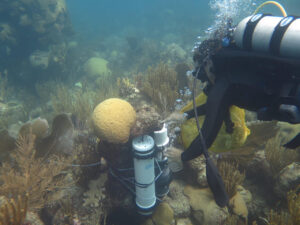
In situ sensors are being deployed at Hog Reef in Bermuda by scientists from Scripps Inst. of Oceanography and the University of Montana. The sensors measure alkalinity, a parameter that is a sensitive indicator of coral reef productivity. Daily cycles of alkalinity are driven by formation of coral calcium carbonate during the daytime and dissolution of calcium carbonate during the night. The balance between day and night cycles indicates whether a reef is growing or losing coral. In the new OTT project, the alkalinity sensor (SAMI-alk) will be combined with a pH sensor (SAMI-pH) into a single unit to provide critical data for tracking coral health and the impacts of ocean acidification.
Increased carbon dioxide in the ocean, ocean acidification, has a stark impact on shell growing organisms, as well as impacting the health of fish, sea grasses, and whole ecosystems. This project will develop technology that can be used to improve our understanding of ocean acidification, both its magnitude and effect on marine organisms, through a two-prong approach. First, the project will combine two proven carbon measurement systems (SAMI-pH and SAMI-alk) into a single device capable of quantifying the inorganic carbon parameters. Second, the team will work with the Hawaii-based PacIOOS to test prototype instruments on the CRIMP2 MapCO2 buoy in Kaneohe Bay, Hawaii.
PI: Mike DeGrandpre, University of Montana
IRA Funded Ocean Technology Transition award: $935,976
 Official websites use .gov
A .gov website belongs to an official government organization in the United States.
Official websites use .gov
A .gov website belongs to an official government organization in the United States.
 Secure .gov websites use HTTPS
A lock or https:// means you’ve safely connected to the .gov website. Share sensitive information only on official, secure websites.
Secure .gov websites use HTTPS
A lock or https:// means you’ve safely connected to the .gov website. Share sensitive information only on official, secure websites.
